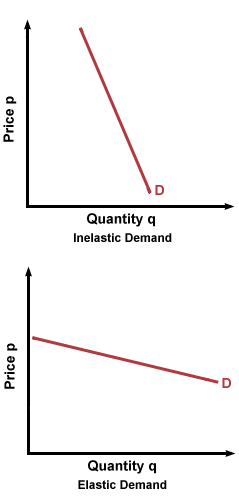Marketing Guides
Strategic Planning
Will Lowering Your Prices Increase Profits?
Revenue is down and you need to take action. In a slow economy, it’s reasonable to assume that if you were to lower your prices, you’d sell more and increase revenue and profits. But is this always true?
Maybe, or maybe not.
The untrained business person might feel that this was the best pricing strategy, but Economics 101 tells us that the answer to this question is a definite maybe.
It depends on your demand curve.

If you had the chance to study basic micro economic theory in college (who didn’t?), then you know that the slope of your demand curve tells you how sensitive your market is to price changes.
Examples courtesy of Sparknotes.
If your demand curve is perfectly inelastic, customers will purchase the same volume from you at a higher price (and at a lower price). If, on the other hand, it’s perfectly elastic, they’ll buy nothing from you if you raise your price. The reality is that 99.99% of companies fall somewhere in between.
How to Determine If Lowering Your Prices Will Increase Profits
How can you determine your demand curve without hiring an economist?
The answer is estimate. If you’re considering a pricing strategy change and you don’t know how your market will respond, survey your market to predict the results.
Select a group of current customers and lost prospects with whom you established a relationship during the sales cycle.
You’re trying to determine how many new units existing customers would purchase, and how many new units current customers would purchase, if you increased and decreased your prices by x% (let’s say 5%, 10% and 20%). Finesse the language of your questions based on your relationships and how you decide to position the survey. Shoot for a statistically significant number, and summarize your results.
You don’t need to plot your results on a supply and demand graph to project your optimal price – the one that delivers the greatest profit – but you can still get a feel for how elastic your demand curve is, which is fancy language for saying how responsive the market is to price changes. If you have an elastic demand curve:
-
When you raise prices slightly, volume goes down substantially.
-
When you lower prices a slightly, volume goes up substantially.
Conversely, if your volume stays roughly the same when you increase your prices, you have an inelastic demand curve. This can be very powerful, and it typically results from having a premium brand, solid distribution, few competitors or simply being under-priced.
Multiply price by quantity at each new price to determine your revenue and profit projections. Be sure your projections show greater profit before you decide to lower your prices.
Here are some step-by-step plans and calculators for determining your optimal pricing strategy and calculating revenue and profit.
PRICING STRATEGY TEMPLATES / MARKETING PLANS / PROJECT MANAGEMENT
EVERYTHING YOU NEED FOR YOUR MARKETING PROJECT